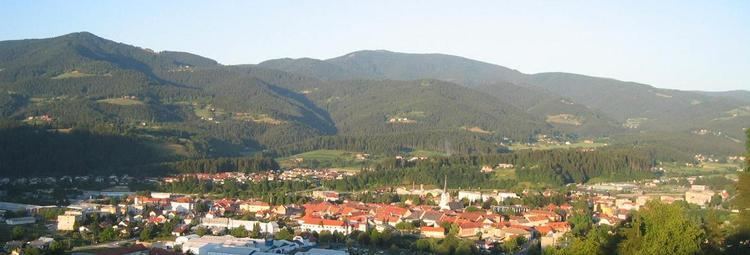Climate Cfb Area 5.6 km² Local time Friday 10:34 AM | Municipality Slovenj Gradec Elevation 413 m Population 7,557 (2012) Number of airports 1 | |
 | ||
Weather 14°C, Wind NW at 6 km/h, 59% Humidity | ||
Slovenj Gradec ([slɔˈʋeːn ˈɡɾaːdəts]; German: Windischgrätz, after about 1900 Windischgraz) is a town in northern Slovenia. It is the centre of the City Municipality of Slovenj Gradec. It is part of the historical Styria region, and since 2005 it has belonged to the NUTS-3 Carinthia Statistical Region. It is located in the Mislinja Valley at the eastern end of the Karawanks mountain range, about 45 km (28 mi) west of Maribor and 65 km (40 mi) northeast of Ljubljana.
Contents
- Map of 2380 Slovenj Gradec Slovenia
- History
- Main sights
- Notable residents
- Twin towns Sister cities
- References
Map of 2380 Slovenj Gradec, Slovenia
History
Gradec, Slovene for 'little castle', was first mentioned in a 1091 deed, then part of the Imperial March of Styria. The prefix Windisch (the traditional German name for Slavs in general and Slovenes in particular) was added to distinguish it from the city Graz (whose name has the same etymology). The modern Slovene name, Slovenj Gradec (literally: the Slovene Graz), derives from this German denomination. From 1180 until 1918, Slovenj Gradec belonged to the Duchy of Styria, since 1804 a crown land of the Austrian Empire. It was the ancestral seat of the Windisch-Graetz noble family first documented in 1220. Upon the dissolution of Austria-Hungary in 1918, with the rest of Lower Styria, it was included in the newly established Kingdom of the Serbs, Croats and Slovenes.
Until 1918, the town was a German-speaking island in a Slovene-speaking area. In the 1880 census, the town of Slovenj Gradec was 75 percent German-speaking and 25 percent Slovene-speaking,. Many inhabitants, like the family of the composer Hugo Wolf, were of mixed ethnic origin. After the end of World War I, many of the local German-speaking inhabitants emigrated to Austria. Those who remained were gradually assimilated into the now Slovene-speaking majority. During World War Two, the town was occupied by the Nazis and annexed to the Third Reich. The local Slovenes were submitted to a policy of violent Germanization and many died of various persecutions. The partisan insurgency developed in the area, especially in the hills to the east of the town. After World War II, the remaining ethnic Germans were expelled from Yugoslavia, and Slovenj Gradec lost its traditional presence of German speakers.
From the 1950s onward, the town experienced a rapid industrialization and eventually became the unofficial economic and political center for Slovenian Carinthia. In 1994, it became one of the 11 towns in Slovenia with the status of City (or Urban) Municipality.
Main sights
The parish church in the town is dedicated to Saint Elizabeth of Hungary and belongs to the Roman Catholic Archdiocese of Maribor. It was first mentioned in written documents from 1235. Next to it stands a Gothic chapel dedicated to the Holy Spirit with frescos dating to the mid-15th century.
In 2003, an archeological excavation uncovered the remains of what is believed to be the oldest church in Styria, dating to the Carolingian period.
The Slovenj Gradec Art Gallery (Slovene: Koroška galerija likovne umetnosti) was founded in 1957 and is located on the first floor of the old town hall in the town centre. The gallery hosted international fine art exhibitions under the sponsorship of the United Nations in 1966, 1975, 1979, 1985, and 1991. The 1997 exhibition "The Artist and Urban Environment" displayed art activity in Peace Messenger Cities from all over the world. In 2012, Slovenj Gradec and Ptuj were partners with Maribor, the European Capital of Culture. As a result, the gallery presented further exhibitions that attracted Europe-wide attention.
Notable residents
Notable people that were born or lived in Slovenj Gradec include:
Twin towns — Sister cities
Slovenj Gradec is twinned with:
